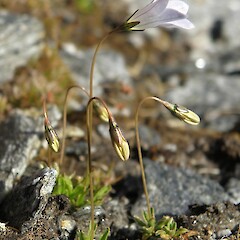Wahlenbergia albomarginata subsp. albomarginata
Common name
New Zealand harebell, harebell
Synonyms
Wahlenbergia brockiei J.A.Hay
Family
Campanulaceae
Flora category
Vascular – Native
Endemic taxon
Yes
Endemic genus
No
Endemic family
No
Structural class
Herbs - Dicotyledons other than Composites
NVS code
The National Vegetation Survey (NVS) Databank is a physical archive and electronic databank containing records of over 94,000 vegetation survey plots - including data from over 19,000 permanent plots. NVS maintains a standard set of species code abbreviations that correspond to standard scientific plant names from the Ngä Tipu o Aotearoa - New Zealand Plants database.
WAHASA
Chromosome number
2n = 36
Current conservation status
The conservation status of all known New Zealand vascular plant taxa at the rank of species and below were reassessed in 2017 using the New Zealand Threat Classification System (NZTCS) – more information about this can be found on the NZTCS website. This report includes a statistical summary and brief notes on changes since 2012 and replaces all previous NZTCS lists for vascular plants.
Please note, threat classifications are often suggested by authors when publications fall between NZTCS assessment periods – an interim threat classification status has not been assessed by the NZTCS panel.
- Conservation status of New Zealand indigenous vascular plants, 2017 . 2018. Peter J. de Lange, Jeremy R. Rolfe, John W. Barkla, Shannel P. Courtney, Paul D. Champion, Leon R. Perrie, Sarah M. Beadel, Kerry A. Ford, Ilse Breitwieser, Ines Schönberger, Rowan Hindmarsh-Walls, Peter B. Heenan and Kate Ladley. Department of Conservation. Source: NZTCS and licensed by DOC for reuse under the Creative Commons Attribution 4.0 International licence.
2017 | Not Threatened
Previous conservation statuses
2012 | Not Threatened
2009 | Not Threatened
2004 | Not Threatened
Distribution
Endemic. New Zealand: South Island (in the east from Marlborough to Central Otago)
Habitat
Lowland to subalopine in tussock-grassland, on river terraces and amongst rocks.
Wetland plant indicator status rating
Information derived from the revised national wetland plant list prepared to assist councils in delineating and monitoring wetlands (Clarkson et al., 2021 Manaaki Whenua – Landcare Research Contract Report LC3975 for Hawke’s Bay Regional Council). The national plant list categorises plants by the extent to which they are found in wetlands and not ‘drylands’. The indicator status ratings are OBL (obligate wetland), FACW (facultative wetland), FAC (facultative), FACU (facultative upland), and UPL (obligate upland). If you have suggestions for the Wetland Indicator Status Rating, please contact: [Enable JavaScript to view protected content]
FACU: Facultative Upland
Occasionally is a hydrophyte but usually occurs in uplands (non-wetlands).
Detailed description
Perennial herb with radical, rosulate tufts of leaves, sometimes alternate on elongated stems (shade form). Leaves concolorous or paler beneath, yellow-green, green to red-green, turning glaucous on drying; more or less petiolate, lamina 10 × 2 to 40 × 10 mm, linear to elliptic, gradually narrowed to petiole as long as the lamina or longer, margins entire or subentire, thickened, teeth if present, inconspicuous. Flowers insect-pollinated, narrowly campanulate-rotate, corolla pale flax blue to pale blue-violet, often with white zoning and deeper coloured veins, or all white, 12-17 mm diameter, 10-20 mm long, corolla tube 4 × 3 to 10 × 6 mm, lobes 6 × 3 to 12 × 5 mm; style equal in length to corolla tube, lobes 2 or 3. Calyx lobes less than ¼ corolla length; capsule domed cylindric, 6-8 × 4 mm. Seeds 0.5 mm long, ellipsoid, smooth, glossy brown when mature.
Similar taxa
Wahlenbergia albomarginata subsp. albomarginata is distinguished from subsp. decora J.A.Pettersen, subsp. flexilis (Petrie) J.A.Pettersen, subsp. laxa (G.Simpson) J.A.Pettersen and subsp. olivina J.A.Petetrsen by its inland eastern South Island distribution (and virtual restriction within this area to low-rainfall regions), and by its entire, linear to elliptic leaves which are often white margined. All of the W. albomarginata subspecies recognised by Petterson (1997), except perhaps the ultramafic endemic subsp. olivina, require a thorough revision, as many of the characters used to separate them are overlapping.
Flowering
November – April
Flower colours
Blue, Violet/Purple
Fruiting
December - April
Propagation technique
Easily grown from tip cuttings and the division of whole plants. Fresh seed germinates readily. Being insect-pollinated and having an indigenous pollinator, cultivated plants rarely set seed.
Etymology
wahlenbergia: Named in honour of Wahlenberg, a Swedish botanist and author of A Botany of Lapland.
albomarginata: From the Latin albus ‘white’ and marginatus ‘having a border or margin’ meaning something with a white margin, often referring to leaves
Where To Buy
Not Commercially Available
Attribution
Fact Sheet prepared for NZPCN by P.J. de Lange 12 June 2007. Description from Petterson (1997).
References and further reading
Petterson, J.A. 1997: Revision of the genus Wahlenbergia (Campanulaceae) in New Zealand. New Zealand Journal of Botany 35(1): 9-54
NZPCN Fact Sheet citation
Please cite as: de Lange, P.J. (Year at time of access): Wahlenbergia albomarginata subsp. albomarginata Fact Sheet (content continuously updated). New Zealand Plant Conservation Network. https://www.nzpcn.org.nz/flora/species/wahlenbergia-albomarginata-subsp-albomarginata/ (Date website was queried)


